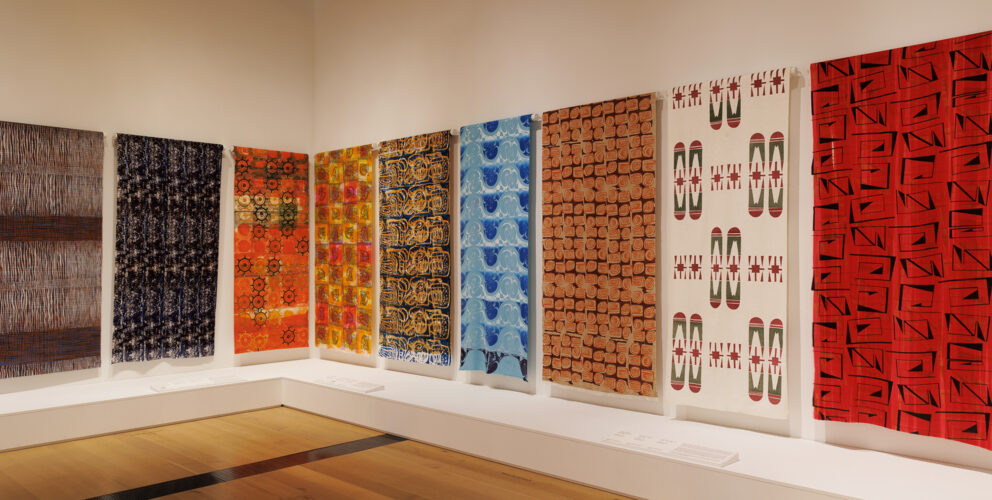Alexander Brier Marr, the Saint Louis Art Museum’s associate curator of Native American art, answers questions about Action/Abstraction Redefined: Modern Native Art, 1940s–1970s, on view through September 3. This is the first major exhibition at the Museum to focus on Native American art of the 20th century, offering a focused view on the use of abstraction in studio-based practice following World War II.
These experimental, visually dynamic works will engage visitors and then introduce them to the historical framework of the exhibition. Key themes include the multiple lineages of abstraction in North America, the changing value of Indigenous heritage in the mid-20th century, and the ability of artists to shape the social, economic, and institutional contexts in which they work.

Alexander Brier Marr, the Saint Louis Art Museum’s associate curator of Native American art
What do you hope visitors will take away from the exhibition?
I hope visitors leave the exhibition feeling more familiar with the field of Native American art in general. Action/Abstraction Redefined fills in the chronology of Native art, addressing a midcentury gap in Museum collecting and programming. The period covered by the exhibition—from the 1940s to the 1970s—was characterized by complex shifts in artistic practice. Starting in the late 1940s Native artists broadly expanded the technical, conceptual, and aesthetic horizons of their work by training in mainstream universities and art schools. By the early 1960s conferences, workshops, and tentative reforms in federal policy led to the founding of the Institute of American Indian Arts (IAIA) in Santa Fe, New Mexico. The teaching philosophy at IAIA emphasized “cultural difference as the basis for creative expression.” This concept, articulated and institutionalized by artist and administrator Lloyd “Kiva” New, promoted the study of Native aesthetics and individual experimentation. Students also learned about global art history and contemporary art movements. This artistic approach sparked an outpouring of innovation that transformed the cultural landscape well beyond Santa Fe. The movement in contemporary Native art continues to reverberate and gain steam today.
Like many comprehensive art museums in the United States, the collection at SLAM is strong in 19th-century Native American art, especially women’s abstraction from the plains and the Southwest. And, like most peer institutions, SLAM is building a collection of Native American art from the last 30 years, including works by Dyani White Hawk, Truman Lowe, Edgar Heap-of-Birds, Cara Romero, Wendy Red Star, and Jaune Quick-to-See-Smith. What has been missing here, and missing from museums across the US, is the central chapter in a continuous history of Native American art.

Installation image from Action/Abstraction Redefined: Modern Native Art, 1940s–1970s
What are the Missouri connections in this traveling exhibition?
The exhibition features works from two leading Osage artists of the 20th century. Jim Lacy Red Corn screen printed a textile as a student in the Southwestern Indian Arts Project, a Rockefeller-funded workshop at the University of Arizona in the early 1960s. The exhibition also includes a focused presentation of prints and a painting by Anita Fields that the artist made during her time as a student at IAIA. The Osage Nation is one of the Indigenous groups most strongly associated with Missouri and the St. Louis region before the 1808 Treaty of Fort Clark.

Installation image from Action/Abstraction Redefined: Modern Native Art, 1940s-1970s
What role do women artists play in this exhibition and the Native Abstract art movement in general?
The exhibition presents the work of many women artists. This includes artists both successful in recent decades—Kay WalkingStick, Anita Fields, Linda Lomahaftewa, Christine McHorse—and those whose work deserves greater recognition, such as Enda Massey, Mary Sully, and Otellie Loloma. This is an important corrective to popular accounts of art making associated with the early years of IAIA that focus on pop figuration by male artists such as Fritz Scholder and T. C. Cannon. Native women have created abstract designs across a range of media for millennia, so it is critical to foreground the roles of women artists in shaping the movement for contemporary Native American art.

Installation image from Action/Abstraction Redefined: Modern Native Art, 1940s–1970s
How does this exhibition impact the narrative of Abstract art?
The exhibition expands the narratives of Abstract studio art in the US in the decades following WWII. It demonstrates how Indigenous artists participated in national movements and styles by bringing their own artistic heritage to bear on vocabularies of abstraction. The exhibition also updates histories of Indigenous abstraction. Transformed in the studios at IAIA and across the country, older abstract motifs and designs convey more than historical information. Historic works can now be seen as active, vital source material for contemporary Native artists, works that continue to shape present-day life.

Installation image from Action/Abstraction Redefined: Modern Native Art, 1940s–1970s
What did you learn about modern and contemporary Native art through curating this exhibition?
The exhibition includes a number of artists whose work deserves greater recognition. I learned about several artists, such as Edna Massey, for the first time through exhibition research. I also learned more about the early careers of major artists such as Fritz Scholder, who made fantastic abstract paintings before turning to figuration in 1967, the work that made him famous. More than learning about individual artists, however, I now recognize the breadth of abstraction in postwar studio practice by Indigenous painters, sculptors, printmakers, and textile artists. For me, this recognition radically expands the origin stories of the contemporary Native American art movement, pointing toward a more robust account of Indigenous artistic agency and continuity through the earth-shaking 20th century.
The touring exhibition is curated by Manuela Well-Off-Man, chief curator, IAIA Museum of Contemporary Native Arts; Tatiana Lomahaftewa-Singer, curator of collections, IAIA Museum of Contemporary Native Arts; and Lara Evans, former IAIA professor of Native art history. The expanded St. Louis presentation is curated by Alexander Brier Marr, associate curator of Native American art, and Hannah Klemm, SLAM’s former associate curator of modern and contemporary art.
